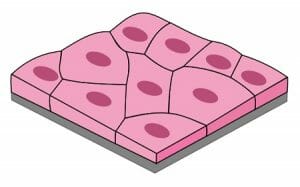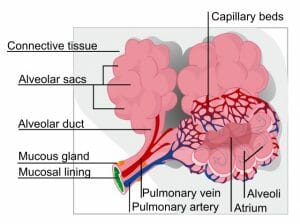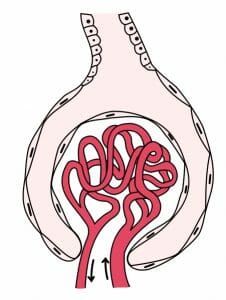Simple Squamous Epithelium Definition
Simple squamous epithelia are tissues formed from one layer of squamous cells that line surfaces. Squamous cells are large, thin, and flat and contain a rounded nucleus. Like other epithelial cells, they have polarity and contain a distinct apical surface with specialized membrane proteins.
Functions of Simple Squamous Epithelium
These epithelia are common where absorption or transport of materials is important. They also play a role in diffusion, osmosis and filtration. This makes them important in the kidney, in the alveoli of lungs and in the walls of capillaries.
Since this epithelium is made of a single layer of thin cells that are tightly packed together, it is the ideal medium for selective transmembrane transport. Some substances, such as oxygen from the lungs travel mostly along their concentration gradient towards the blood. Others are actively transported using membrane-bound carrier proteins.
Membrane proteins are involved in forming tight junctions to ensure that the movement of ions, gases, small molecules or water occurs only through the cell and there is no diffusion or osmosis through the interstitial spaces. The rest of the plasma membrane makes up the basolateral surface.
Examples of Simple Squamous Epithelia
Simple squamous epithelia are found in a variety of locations, starting from capillaries to the alveoli of lungs, and nephrons of kidneys. Most of these cells arise from the ectoderm, or outermost layer of cells in the embryo. However, some simple squamous epithelial tissues are also derived from the mesoderm or middle layer of embryonic cells. These are called the mesothelia, especially in pathological studies. These tissues line several body cavities including the pleural cavity that houses the lungs, peritoneum (abdominal cavity containing the stomach and intestines) and the mediastinum (part of the thoracic cavity that contains the heart, lungs, trachea and esophagus). These tissues are also called the endothelium when they form the inner lining of blood and lymph vessels.
Example I: Alveoli of the Lung
Air enters the body through the nostrils and passes through a series of tubular structures such as the pharynx, larynx, trachea, and the branching network of bronchi to end in alveoli. Pulmonary alveoli are structures that resemble a set of florets at the end of a stalk. These highly vascularized bulbous structures are made of a single layer of squamous cells and are surrounded by an intricate network of capillaries.
Capillaries are also made of a single layer of squamous cells and this allows for gas exchange between the alveoli and blood vessels. Each day, approximately 12,000 liters of air pass through the lungs and are used for obtaining oxygen for the body and expelling carbon dioxide. The two sets of simple squamous epithelia play a crucial role in this important bodily function.
Example II: Bowman’s Capsule in the Kidney
The blood is a major organ for transporting nutrients and removing wastes. One of the most important waste products of the body are nitrogenous substances generated as a result of protein and nucleic acid metabolism. These substances are removed from the blood at structures called glomeruli in the kidney. The kidney is made of a million functional subunits called nephrons. A glomerulus is a small tuft of capillaries that interacts closely with one end of a nephron: the Bowman’s capsule.
In this image, capillaries are colored red with the Bowman’s capsule surrounding them. The outer wall of the Bowman’s capsule is made of a single layer of squamous cells, and the inner surface, in close proximity to capillaries is a modified form of simple squamous epithelium. The inner or visceral surface contains specialized cells called podocytes that form slit-like structures to facilitate filtration. Between the squamous epithelial cells of the glomerular capillaries and those in the Bowman’s capsule, nearly 180 liters of blood are filtered each day. Every cell in the blood passes through this structure about 20-25 times in the course of a day.
The liquid that is obtained at the start of the nephron is called the glomerular filtrate and through a series of secretion, absorption and reabsorption events, urine is eventually formed, and expelled from the body.
Related Biology Terms
- Apical Surface – Section of the plasma membrane in epithelial cells that faces the lumen of an organ or the external environment.
- Basal Lamina – Extracellular matrix secreted by epithelial cells, which forms a part of the supportive structure called the basement membrane.
- Basement Membrane – A thin membrane made of modified carbohydrates and proteins that separates epithelial cells from the connective tissue underneath.
- Tight Junctions – Specialized connection between two cells, especially in the epithelium, formed by close interaction between two sets of transmembrane proteins that prevent the movement of materials through the interstitial space between two cells.
Quiz
1. Which of these is true about simple squamous epithelia?
A. They are involved in the transport of oxygen and carbon dioxide at the lungs
B. They play a role in the filtration of nitrogenous waste products in the brain
C. They are necessary for secretion and transport of hormones
D. All of the above



